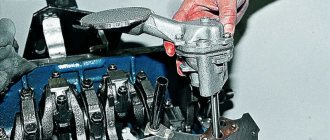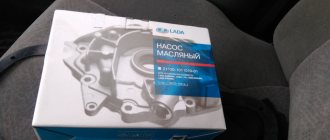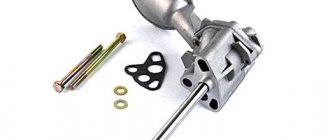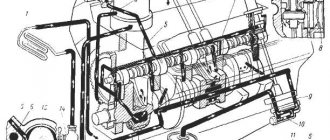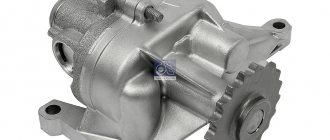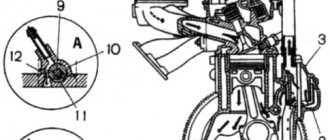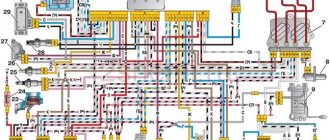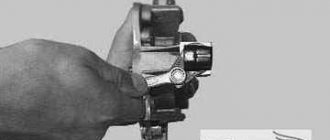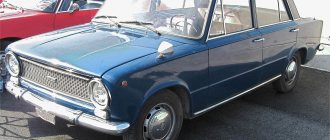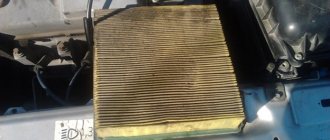A device such as the oil pump on the VAZ 2114 performs one main function - it serves to supply oil to the moving elements of the engine and, thus, lubricates them. It is powered by the operation of the motor itself. On some VAZ models, the pump is mounted on the crankshaft, on others it has additional adapter units, including an additional shaft, a drive belt and other parts that serve to transmit rotation from the crankshaft to the pump.
Oil pump VAZ 2114
Due to the fact that the pump itself has a fairly simple design, problems with it are extremely rare. The nominal service life of this unit is at least 120,000 km of vehicle mileage. Maintenance of the pump is also extremely simple - you just need to periodically replace the oil with new one. The recommended replacement period (prescribed by car manufacturers) is every 10,000 km.
In practice, it is recommended to change the oil more often than every 10 thousand km, since used oil contains an increased amount of metal and abrasive particles, which, in turn, can lead to rapid wear of the oil pump.
Operating principle of the oil pump
Causes of oil pump failure
There are a number of typical breakdowns due to which the oil pump completely or partially fails:
- physical wear of the housing, rotor or driven gear. There is a gap of 0.2 mm between the pump gears and the housing. There is also a gap between the teeth of the pump gears - 0.5 mm. As wear occurs, these gaps increase, and the pressure created by the pump at the outlet pipe drops. Since replacing and adjusting worn gears is a very labor-intensive process and not everyone can do it, car enthusiasts follow the path of least resistance and simply change the entire oil pump;
The gaps in VAZ oil pumps are checked with a special feeler gauge
- clogging of the oil receiver. If it becomes clogged, the pressure in the car's lubrication system drops sharply, and a red light comes on on the dashboard. A clogged oil receiver is a consequence of a completely clogged crankcase. The solution is to completely drain the used lubricant, remove the pan, crankcase, oil pump and thoroughly wash all these parts in kerosene;
A blockage in the oil receiver can completely damage the VAZ oil pump
- oil leak. Sometimes oil begins to leak directly from under the pump. Typically, the driver does not notice a leak immediately, identifying it by indirect signs, for example, by a sharply increased lubricant consumption and oil stains under the car. The cause of the leak is a leak in the pump gasket. Often, when replacing an oil pump, car enthusiasts do not change the gasket located under it, believing that it will serve for some time. This is an error that leads to leaks. The rule is simple: when changing the oil pump, you must also change the gasket, even if it does not look worn out.
Separate mention should be made of motor oil. Its quality also has a significant impact on the service life of the pump and its serviceability. The fact is that the oil pump is the only engine element that is lubricated with unfiltered oil (because the oil filter is installed only on the pump outlet). And if the car owner is used to saving on high-quality oil, then he may not count on long and uninterrupted operation of the oil pump.
Purpose of the oil pump on the VAZ 2114 and VAZ 2115
The main task of the oil pump is to create excess pressure in the engine lubrication system and ensure continuous circulation of oil in the lubrication channels.
Only rotary oil pumps are installed on the VAZ 2114
Any breakdown of the oil pump leads to a drop in lubricant pressure, after which the friction between the moving parts of the engine increases sharply. As a result, almost all engine components are damaged, and they can only be restored after an expensive overhaul.
Types of oil pumps for VAZ 2114 and VAZ 2115
The design of the VAZ 2114 and VAZ 2115 engines is the same. Therefore, the oil pumps on these machines are also exactly the same. These are adjustable rotary pumps equipped with a pressure reducing valve.
Main design elements of the rotary adjustable oil pump VAZ 2114
On earlier VAZ models, gear oil pumps were installed, but VAZ engineers gradually abandoned these devices, since the rotary oil pump has important advantages:
- rotary oil pumps, unlike gear pumps, almost never foam the engine oil in the system;
- if an adjustable rotary oil pump is installed on the car, then the car owner will not have to change the engine oil too often (since the foaming problem has been solved, the working life of the lubricant increases on average by 2.5 times);
- Due to the design features, the oil rotary pump significantly facilitates engine operation. When using oil pumps of this type, engine power increases by 35%.
Location of oil pumps on VAZ 2114 and VAZ 2115
The oil pump on the VAZ 2114 and VAZ 2115 is located under the car engine. It is covered by an oil pan, and the pan, in turn, is covered by a crankcase protection. Therefore, in order to get to the oil pump, the car owner will have to remove these parts, having first driven the car onto an overpass or inspection hole.
To get to the oil pump, you will have to remove the pan and crankcase from the VAZ 2114
Important points
There are a couple of nuances that you definitely need to remember when changing the oil pump:
- Before installing a new oil pump, you need to remove the plastic oil seal from it and generously lubricate its inner edge with engine oil. This will make it much easier to install the pump on the crankshaft;
The inner edge of the oil pump oil seal must be lubricated with oil.
- When the pump is completely seated on the shaft, do not immediately tighten the mounting bolts. First you need to tuck the edge of the above plastic seal inside. This should be done using a pointed stick or pencil. It is strictly not recommended to thread the oil seal with a flat screwdriver or a knife: it breaks very easily, and it is almost impossible to find it on sale.
The VAZ 2114 oil pump oil seal should be filled with a pointed stick or pencil
Replacing the oil pump on VAZ 2114 and VAZ 2115 cars is a task that seems impossible only at first glance. Upon closer examination, it turns out that you can cope with it on your own, saving a significant amount on the services of a qualified auto mechanic.
Copywriter with five years of experience.
Home →
Maintenance and Repair →
Engine →
Design
Today there are three types of pumps:
- 2-gear pumps, in which one gear is connected to a shaft, which starts working from the intermediate or camshaft of the VAZ. This pump is installed inside a sump located in the lower area of the cylinder block. Typically, the rotation speed of the element is ½ the rotation speed of the motor.
- A gerotor pump has a rotating small gear inside an outer gear. This pump is located in the lower area of the motor in the sump.
The internal pump is often installed on the front cover of the engine. It begins to function from the crankshaft. Structurally, such a mechanism is similar to a gerotor mechanism, but in this situation it replaces the front damper of the engine. As a result, it is possible to generate higher oil flow with higher pressure.
Common unit breakdowns
- operational wear of the components of the unit: the pump housing or gears fail: during the operating cycle, the gap between the driven and driving gears increases. In normal condition it does not exceed 0.25 mm. Wear leads to the fact that the distance between the parts increases to 0.5 mm: the gears no longer mesh. The described breakdown makes the oil pump unsuitable for routine repairs - it is easier to buy a new part than to install new gears and adjust them;
- leakage: oil begins to leak from under the pump. The reason for this is a leaky oil pump gasket. Replacing the gasket solves the problem;
- Oil receiver clogged: The oil receiver becomes clogged due to a clogged crankcase. In this case, you need to dismantle the oil pan and clean the mechanism.
In most cases, it is necessary to purchase a new oil pump. The price of a new part in online stores is in the range of 1700 - 2500 rubles. The devices are compatible with the first generation Samara.
Signs and causes of oil pump malfunction Lada 2114
There are several markers, the appearance of which will allow you to suspect defects in the pump:
- The corresponding light on the dashboard lights up;
- Oil puddles regularly form under the car;
- Smoke is generated during engine operation.
Causes of unit malfunctions:
- use of motor oil that does not comply with the car manufacturer’s recommendations;
- oil filter clogged;
- permanently low level of lubricating fluid in the crankcase;
- non-working condition of oil level monitoring devices;
- failure of the engine lubrication system valve;
- impurities entering the engine oil (most often coolant is mixed with it).
All the described breakdowns are accompanied by activation of the control lamp, so do not delay repairs; begin service operations after activating the control indicator.
What is this?
Replacing the crankshaft oil seal means removing the worn seal system from the vehicle and installing a new one. The oil seal is designed to prevent engine fluid from leaking from the engine.
The following signs indicate that it is time to change the crankshaft seal:
- Increased oil consumption.
- The appearance of oily spots around the oil seal.
- Problems with the motor.
If you do not replace a worn oil seal, there is a high probability that after a while the engine will fail and will require major repairs. Automotive service center technicians dismantle and install automobile parts.
To change the oil seal successfully, you need to do a number of the following:
- Contact a car service.
- Tell the technician the essence of the problem.
- Wait for a specialist to conduct a diagnosis.
- Find out the cause of the problem and discuss a plan to solve the problem.
- Give consent for repairs.
- Wait until the technician installs the new seal.
- Check the operation of the machine.
- Pay a specialist.
- Receive a warranty card.
How to replace the oil pump?
Tools
Before we talk about how to remove the oil pump on a VAZ 2114, we first outline the list of tools necessary for this:
- open-end wrenches “10” and “13”;
- set of socket heads;
- gimbal adapter;
- extension;
- crank/ratchet;
- highly desirable - a torque wrench.
Replacement
Before moving on to the description of replacing the oil pump, it is worth noting that according to the rules, the crankshaft oil seal is also replaced at the same time.
The replacement of the VAZ 2114 oil pump itself is carried out in the following order:
- Disconnect the negative cable from the corresponding battery terminal.
- Drain the engine oil.
- Remove the belt from the generator.
- Remove the belt from the camshaft.
- Using a pair of screwdrivers, remove the pulley from the crankshaft (after this you should pay attention to the key - if it does not sit tightly on the shaft, you should remove it and set it aside so as not to accidentally lose it).
- Remove the engine oil sump.
- Remove the pair of bolts securing the oil pickup to the main bearing.
- Unscrew the bolt securing the oil pump to the oil receiver and remove the latter.
- Unscrew the six bolts that secure the oil pump (important - there are flat washers under each bolt).
- Use a screwdriver to pry up the oil pump, resting it between the main bearing and the pump cover, and then move it.
- Remove the pump from the crankshaft.
At this point, the entire process of removing the oil pump can be considered complete.
After the camshaft drive belt is removed during the dismantling process, it is strictly forbidden to turn both the camshaft itself and the crankshaft.
Reinstalling the oil pump occurs in exactly the same order, but in reverse order. Before starting installation, you should inspect the pump and rotate its main gear so that the protrusions on it coincide with the splines located on the crankshaft, and the working edge of the oil seal must be lubricated with liquid lubricant and carefully tucked into the crankshaft journal.
After the new oil pump is installed, a new oil filter should be installed, and then oil should be added to the system. Then you should start the car engine and let it idle for at least three minutes - this is necessary to distribute the oil on its moving elements. After this, the car can be operated as usual.
In conclusion
Finally, it is worth noting another important nuance, which was mentioned above - tightening the bolts that secure the oil pump using a torque wrench. Although it is not necessary to do this, it is highly advisable, because if it is too tight, the gaskets may become displaced and oil will begin to leak. In order to avoid this, tighten the bolts securing the oil receiver with a force of 10 Nm, and the bolts securing the pump itself with a force of no more than 12 Nm.
Source
Disassembly
5mm hex wrench
unscrew the six bolts holding the pump housing and cover together.
2. Separate the pump housing and the cover.
3. Remove the drive gear from the cover.
4. Remove the driven gear from the housing.
Recommendation: The pressure reducing (safety) valve plug is tightened with a large torque. When unscrewing it, you may accidentally damage the pump cover. Also, the turnkey edges on the cork itself are damaged. Therefore, do not disassemble the valve unless necessary. The valve can be washed without disassembling it.
5. We wash the pump parts with diesel fuel or kerosene, wipe them dry and lubricate the gears with clean engine oil.
Pressure reducing valve
There are practically no methods that allow you to check the oil pump pressure relief valve without the need for dismantling. But you can check it with your mouth - even experts recommend using this method. A cloth is applied to the valve fitting, through which air passes well. Next, take a sharp breath. If there is strong resistance, then the valve is working.
If you have a pressure gauge, then you don’t need to tell us how to check the automatic transmission oil pump. The verification principle is the same. Normal pressure level is from 2.5 to 5 Bar. But you need to understand that not only a lack of oil pressure (or rather, ATP fluid) is harmful to an automatic transmission.
Examination
1. Inspect the oil pump parts. They should not show signs of heavy wear, metal coating, cracks or other damage.
2. Using a caliper, measure the diameter of the driven gear seat in the pump housing and the thickness of the partition between the driven and driving gears.
Note: The diameter of the driven gear seat in the pump housing should not exceed 75.1 mm. The minimum thickness of the dividing wall between the drive and driven gears is 3.4 mm.
3. Using a micrometer, measure the thickness of the driven and driving gears. If the thickness of the driven gear is less than 7.35 mm, and the driving gear is 7.41 mm, replace the gears.
4. Place the drive gear in the oil pump housing. Applying the edge of a bench ruler to the mating surface of the oil pump housing, use a set of flat feeler gauges to determine the gap between the edge of the ruler and the gear. Repeat the test with the driven gear.
Recommendation: If the gap between the ruler and the drive gear is more than 0.12 mm (or 0.15 mm for the driven gear), then the gears must be replaced.
Expert advice
In order to check the operation of the oil pump, you will need a liquid pressure gauge. These devices are available in auto parts stores. You can also use any industrial pressure gauge for these purposes, but you should pay attention to the measuring scale - it must be adequate. Then you should stock up on an adapter, which should be screwed into the sensor hole. On its mating part there must be a fitting for the hose or a thread for screwing on the connecting hose. The adapter can be ordered at any turning workshop.

